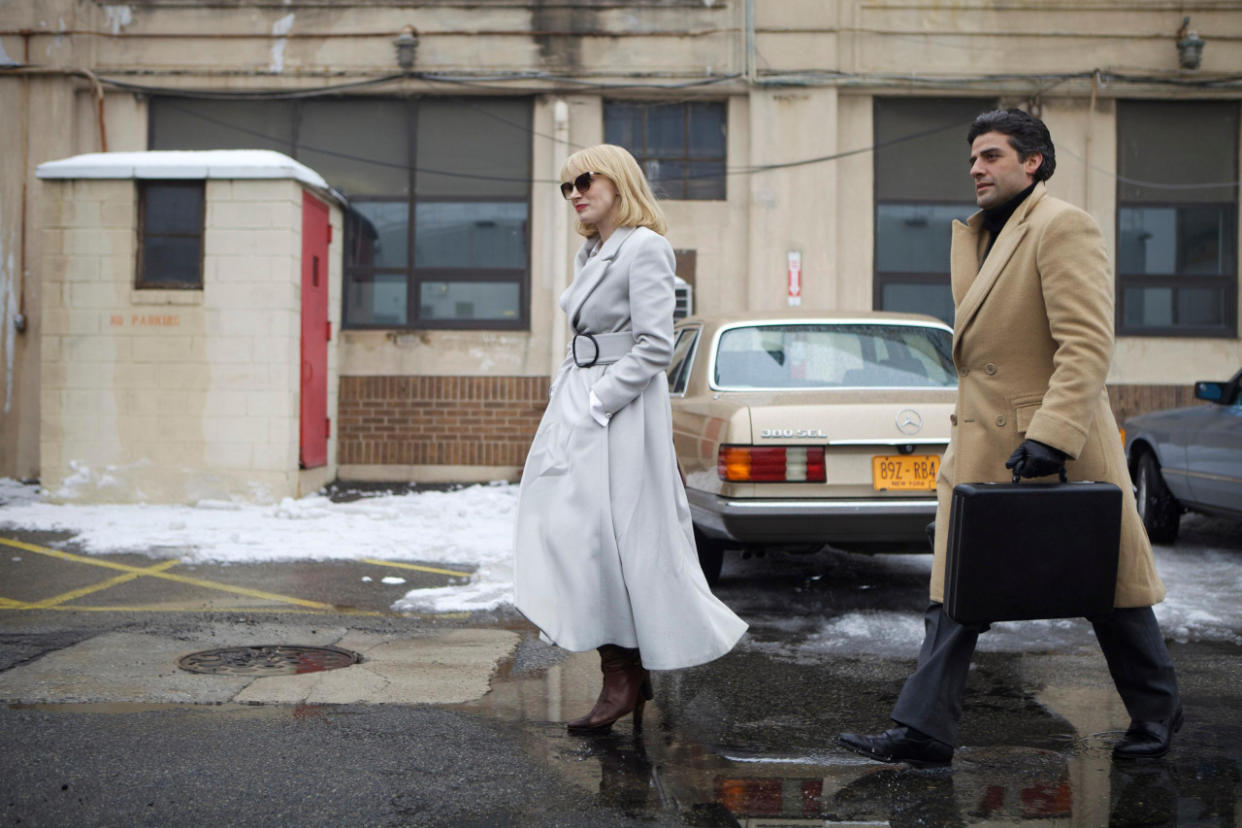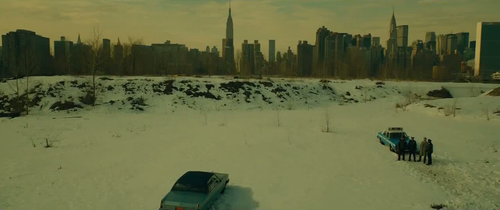Special Effects Secrets of 'A Most Violent Year': Bringing Back the Twin Towers and Making New York City Gritty

Jessica Chastain and Oscar Isaac stalk a grittier New York in A Most Violent Year
In an era of big budget extravaganzas that rely more on computer graphics than the actors at the top of the marquee, visual effects producer Mark Russell has dedicated much of his career to the service of story over spectacle.
Though he began his career by working on Steven Spielberg’s AI: Artificial Intelligence and Minority Report, Russell has spent the last half decade subtly enhancing and adjusting comedies and adult dramas. The highlights for the Blackbox Digital vet include Charlie Kaufman’s Synecdoche, New York; Mike Cahill’s I Origins; Brett Ratner’s Tower Heist; Martin Scorsese’s The Wolf of Wall Street; and J.C. Chandor’s upcoming 1980s-set crime drama, A Most Violent Year.
They are all movies that place emphasis on character and story, but rely a surprising amount on Russell’s ability to shape the background in post-production. His goal: To do work that’s virtually invisible.
“I think the tendency is to put things right up in front and know if you’re going to spend the money on it, you want everyone to see it,” he tells Yahoo Movies. “And I think that’s the wrong approach to visual effects, or at least not as entertaining…. I feel like I’ve done my job if people walk out of the movie theater not thinking about the effects.”
On a modestly budget period drama like A Most Violent Year, what role does a visual effects artist play?
I look at my role in A Most Violent Year as partly creating 1981, along with the production designer, John Goldsmith. Very few buildings have been built in New York since then that are recognizable from Brooklyn. There were a couple we had to get rid of on a regular basis: That big black Trump Tower that’s just above the UN — that was like the blight every time I’d see it.
For me, a lot was adding graffiti, dirtying up New York in shots that looked too clean. New York — I love it now, it’s a wonderful city — but in 1981 it was a very different place. It had this gritty, graffiti texture that we don’t have anymore. A lot of my job was to add that in, in particular in the subway chase. I don’t know if you’ve talked with anyone who’s shot with the MTA [New York’s transit and subway authority] before, but it’s challenging. They’re great, and they allow you to do a lot of things, but they have a lot of restrictions. And one of them was that we couldn’t change the interior or the exterior for that matter. So anytime you see graffiti on the train car, that was me.
What were your graffiti references?
There are a great many books about subway art in the ’70s and ’80s, and we actually had an artist named Bill “Blast” Cordero, who was a graffiti artist back in the ’80s. He painted some murals for us, and we used some of his artwork from the time as well.
So do you line the interior of the car with green screen? Is there a more advanced way now?
We did a laser scan, a Lidar scan of the interior of the train, which gave us the 3D dimensions. So we built a 3D version of the train and then we plastered all our graffiti onto this 3D version. Let’s for the sake of argument call it an invisible 3D version: It has walls and it has geometry, but you can’t see anything, except the graffiti that we put onto it. So once you track the camera that’s inside the train in the real shots, once you photograph them, you track them in 3D, then we put our 3D version inside of that, and it’s tracked along with the real thing. So tracking was very key that it worked perfectly, and then there was a lot of rotoscoping, which was painting people out in the foreground.

A look at A Most Violent Year’s tweaked skyline
Related: Capitalism Is Deadly: Oscar Isaac and JC Chandor on ‘A Most Violent Year’
One thing I did notice: During one scene in Long Island City, you can see a blurry version of the Twin Towers outside a car’s rear window.
Absolutely. The scene where [Abel, Oscar Isaac’s character] meets the cops, that was actually shot right near Hunter’s Point in Long Island City. In the background behind him, when we photographed it, you could see the Freedom Tower, which clearly would have been a big no-no. Actually, they cheated the car, turned it in another direction just to get the right light, so what was actually in the window was the Empire State Building, which should not have been there for that direction. So we got rid of the Empire State Building and replaced it with the Twin Towers.
Were you at all concerned doing that?
No, you’d be surprised how many smaller movies I’d done that to in the last five years. But I think for this one, we never really wanted to call out the fact that the Twin Towers were there, but they’re such an iconic thing, knowing that wherever you were in the city prior to 2001, you would see these things. You’d walk off the subway and say ‘Okay, which direction is south? Oh, there’s the Twin Towers.’ So we liked that idea and wanted to bring that back, in particular the shot at the beginning where they’re re-fueling the trucks in the harbor — a character is on top of the truck and in the distance is Manhattan and the Twin Towers. It’s just a subtle, “Hey, there it is.”
Watch the trailer for A Most Violent Year:
The Wolf of Wall Street is set the ‘90s, not the ‘80s. Did you have to change NYC around a lot for that one?
The difference of budget levels in the movie allowed us to do more of that in camera on the day [of shooting]. Granted, Jordan Belfort [Leonardo DiCaprio’s character] is living in a very different world than Abel, so we didn’t get to see the graffitied parts of Brooklyn. With Wolf of Wall Street, when they’re driving down the road, we could actually afford to have 20 cars surrounding them that were period correct. We did a little bit of period cleanup work, but that movie was more interior-based, as well, which helped us a lot, so it was more about the wardrobe and the choices they made for picking the locations.
The big visual moment from Wolf of Wall Street, in terms of effects, was the storm scene with the yacht. How was that made?
It was all green screen. That was in a parking lot in Steiner Studios in Brooklyn. We basically built a 180-degree green screen stage outside in the parking lot so we could dump water on it, and we put essentially a gimbal, which is this mechanized rotating platform, and had the deck of the bridge on it, and we were able to roll it, tilt it and turn it with the actors in it. But the exterior of the boat was all digital.
Was Scorsese very demanding, or more delegating?
There are certain directors that you work with that are so concerned with continuity from shot to shot, like is an actor’s arm in the same place or does the angle match the cut? And Marty is always concerned about what emotion comes out of the sequence. So when he cuts a movie, he doesn’t care if Leonardo’s shirt was unbuttoned in one shot and buttoned in the next, as long as there’s a continuity in emotion, which is really apparent once you become aware of it. And it makes for more interesting films, because you don’t pay attention to that kind of stuff when you’re engaged in the story.
In the scene that was supposed to be in Windows on the World with Leonardo DiCaprio and Matthew McConaughey, we removed the Freedom Tower and Frank Gehry building, which was just completed, but I don’t know if Marty would have had a problem with keeping it. Part of what he does is hire people who worry about that stuff for him.
How have you seen the effects industry change over your career? Have CGI-dominated movies taken over?
“Taken over” might be a little harsh, but I guess it’s probably not a bad way to describe it. I feel like there are two categories of movies that get made, not counting indie films. There’s movies that are about the effects, and there are movies where the effects help the movie. Not that the two are exclusive, because I think you can have a movie about effects, where the effects help the movie, but most are spectacle movies, which is most of what makes money nowadays.
I’m not as big a fan of those spectacles as you would think, being in my position. I feel like effects-driven movies have lost a lot of ground. They’re not as interesting anymore, because they become about the effects and not the story. Every effects movie is about “What can we show that they’ve never seen before?” rather than figuring out a way to show it well and make it emotional. It’s become about how many robots can you have on screen at the same time, or how big can the horde be that attacks the other horde. Who cares?
You’re doing J.C. Chandor’s Deepwater Horizon movie soon — that sounds like one of those that could be a smart movie that requires visual effects.
I feel like you’ve got the elements of an effects movie, but a director who doesn’t generally make those kinds of movies. The convergence of that will be interesting, because you need the visual effects in order to make a 400 foot flame. But at the same time, he’s going to make a movie about people and the heroism on the day, and to me that’s what was most interesting about it. The effects will be secondary to the story.

